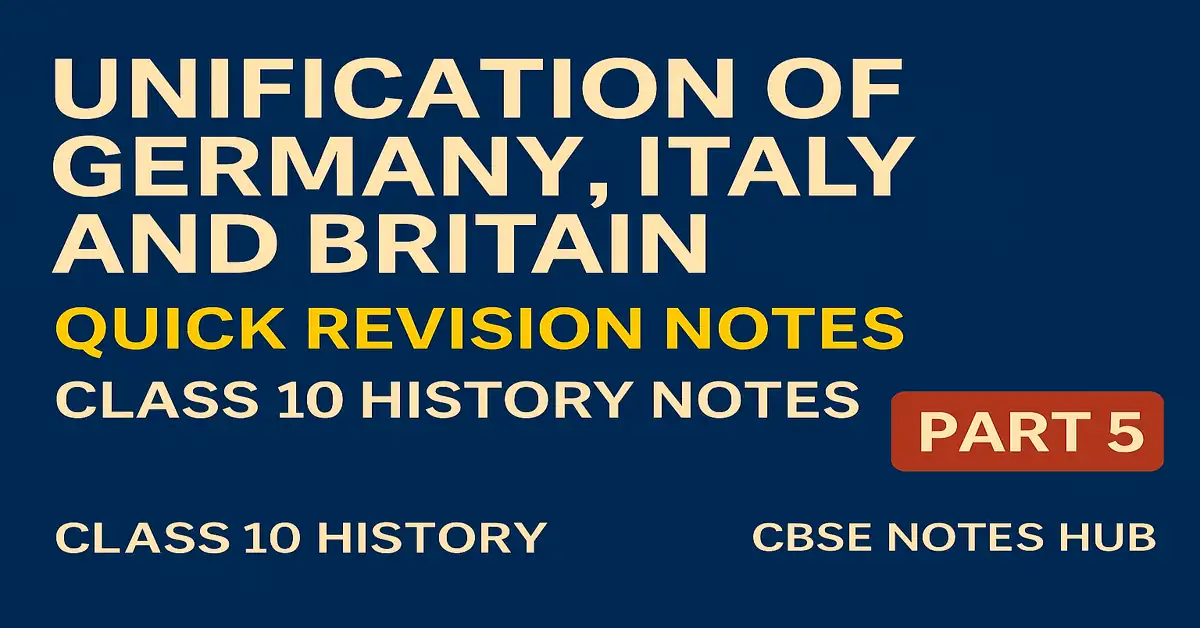This post helps you understand the process of the Unification of Germany, Italy, and Britain, who played the key role in it, and how the Unification of Britain was different
Unification of Germany, Italy and Britain – Class 10 History Notes (Part 5)
Unification of Germany
- Before unification, Germany was divided into 39 states (Empire).
- First failed attempt of unification – in 1848 at the Frankfurt Parliament.
- After Frankfurt Parliament – the leader state of unification was Prussia.
- Chief architect – Otto von Bismarck.
- Bismarck carried out the process with the help of the Prussian army and bureaucracy.
- The unification process was completed through three wars over seven years – with Austria, Denmark, and France.
- Wars ended in Prussian victory.
- Unification took place on 18 January 1871.
- Head after unification – Prussian King Kaiser William I.
- Ceremony held at the Palace of Versailles.
- Changes after unification – modernising the currency, banking, legal, and judicial systems.
Unification of Italy
- Before unification, Italy was divided into seven states.
- State ruled by an Italian princely house – Sardinia-Piedmont.
- Efforts made by Giuseppe Mazzini to make a unitary Italian Republic.
- He formed two secret societies – Young Italy and Young Europe.
- Both uprisings (in 1831 and 1848) failed.
- After 1848 – responsibility to unify Italian states passed to Sardinia-Piedmont under King Victor Emmanuel II.
- The entire movement of unification was led by Chief Minister Cavour.
- He was a skilled diplomat and used alliances to unify Italy.
- Under his leadership, Sardinia-Piedmont defeated Austrian forces in 1859.
- Many volunteers joined under Giuseppe Garibaldi (Red Shirts).
- In 1861, Victor Emmanuel II was proclaimed the King of united Italy.
📘 Must Read
Unification of Britain
- Prior to the eighteenth century, there was no British nation.
- Unification of Britain was a long, drawn-out process.
- Primary groups – English, Welsh, Scots and Irish.
- They had their own cultural and political traditions.
- The English Parliament took control from the monarchy in 1688 and became the main force behind a unified nation-state.
- In 1707, the Act of Union unified England and Scotland to form the United Kingdom of Great Britain.
- Scotland’s culture and political identity were gradually suppressed through government measures.
- In Ireland, Protestants established dominance over a largely Catholic country with English support.
- After a failed revolt led by Wolfe Tone and the United Irishmen (1798), Ireland was forcibly incorporated into the United Kingdom in 1801.
Changes after the Unification of Britain
- Symbols of the new Britain – the British flag, the national anthem, and the English language were actively promoted.
Source: NCERT
📘 Also Read
- Source Based Questions – Class 10 History Chapter 1
- Class 10 History Chapter 1 – Important Questions for CBSE 2026

